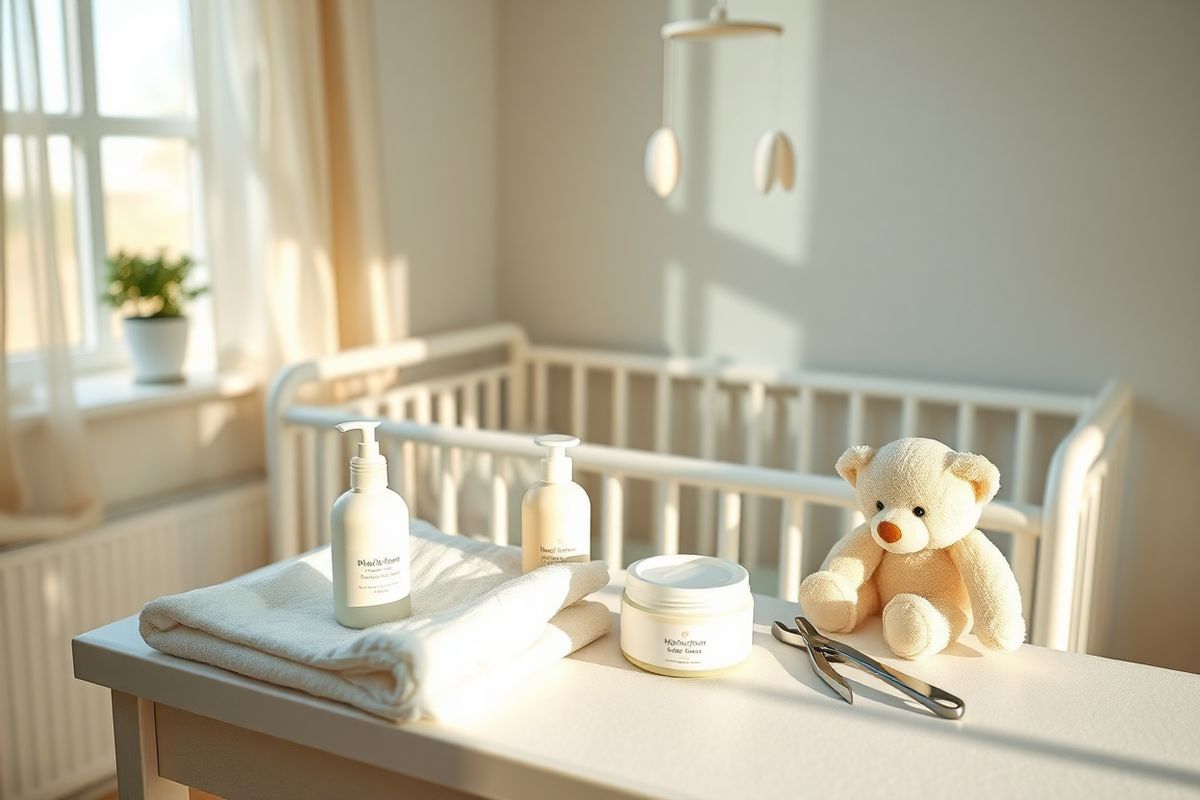Table of Contents
Understanding Diaper Rash: Causes and Symptoms

diaper rash, also known as diaper dermatitis, is characterized by inflammation of the skin in the diaper area. The condition can result from various factors, including prolonged exposure to moisture, friction from diapers, and reactions to products like wipes or creams. The symptoms of diaper rash can vary in severity and presentation. Mild cases typically manifest as slightly reddened skin, while more severe cases may lead to blistering, open sores, or infections.
Types of Diaper Rash
-
Irritant Diaper Rash: The most common type, caused by prolonged contact with urine and feces. This type is characterized by red, shiny patches on the skin, particularly on the buttocks and thighs (Cleveland Clinic, 2024).
-
Candida Diaper Rash: This fungal infection results in bright red patches with defined edges, often seen in the skin folds. It can occur after antibiotic use, which may disrupt the natural balance of bacteria in the area (Cleveland Clinic, 2024).
-
Bacterial Diaper Rash: Rare but can occur, usually characterized by yellow crusting or oozing sores. Staph and strep bacteria are commonly implicated in these infections (Cleveland Clinic, 2024).
-
Allergic Reaction: Sensitive skin may react to specific brands of diapers, wipes, or creams, leading to a rash that typically appears soon after exposure to the irritant (KidsHealth, 2024).
Key Practices for Effective Diapering and Hygiene
Implementing proper diapering techniques can significantly reduce the occurrence of diaper rash. Here are some essential practices to follow:
-
Frequent Diaper Changes: Change your baby’s diaper as soon as it is wet or soiled. This helps minimize moisture on the skin, reducing the risk of irritation (Mayo Clinic, 2024).
-
Gentle Cleansing: Use warm water and a soft washcloth to clean the diaper area. Avoid using wipes with alcohol or fragrance, as these can further irritate the skin (Tips to Avoid Diaper Rash, 2024).
-
Air Exposure: Allow your baby’s skin to air dry whenever possible, and consider letting your baby go without a diaper for short periods to promote healing (Tips to Avoid Diaper Rash, 2024).
-
Barrier Creams: Apply a thick layer of barrier cream containing zinc oxide or petroleum jelly at every diaper change. This forms a protective layer that shields the skin from moisture and irritants (Mayo Clinic, 2024).
-
Diaper Fit: Ensure that diapers fit comfortably and are not too tight, as excessive friction can exacerbate irritation. If using cloth diapers, ensure they are washed thoroughly and free from detergent residues (Mayo Clinic, 2024).
The Importance of Gentle Skin Care for Your Baby

Maintaining a gentle skin care routine is vital for preventing diaper rash. Newborns have delicate skin that is more susceptible to irritation. Here are some skin care tips:
-
Bathing: Bathe your baby only two to three times a week to prevent the skin from drying out. Use mild, fragrance-free soap and ensure that the umbilical cord stump is fully healed before submerging the baby in water (NM, 2024).
-
Moisturizing: Avoid using oils or lotions that may cause irritation. If your baby has dry skin, consult a pediatrician for suitable moisturizing products (NM, 2024).
-
Nail Care: Regularly trim your baby’s nails to prevent scratching the skin, which can lead to infections. It’s best to do this after a bath when nails are softer (NM, 2024).
When to Seek Help: Recognizing Severe Diaper Rash
While most diaper rashes can be treated at home, there are instances when medical attention may be necessary. Seek help from a healthcare provider if:
- The rash does not improve with home treatment after 2-3 days.
- You notice blisters, pus-filled sores, or a rash that spreads.
- Your baby develops a fever alongside the rash (Mayo Clinic, 2024).
Top Remedies and Treatments to Soothe Diaper Rash
When diaper rash occurs, a few effective treatments can help alleviate discomfort and promote healing:
-
Hydrocortisone Cream: For more severe rashes, a mild hydrocortisone cream (0.5% to 1%) may be recommended by a healthcare provider for short-term use (Mayo Clinic, 2024).
-
Antifungal Cream: If a fungal infection is suspected, topical antifungal creams can help treat the rash (Cleveland Clinic, 2024).
-
Antibiotic Treatment: In cases of bacterial infection, oral antibiotics may be necessary to manage the infection (Mayo Clinic, 2024).
-
Regular Monitoring: Keep a close eye on the rash’s progression and any accompanying symptoms. Regular follow-ups with a pediatrician may be beneficial if the rash persists (Mayo Clinic, 2024).
FAQ
How can I prevent diaper rash?
To prevent diaper rash, change your baby’s diapers frequently, clean the diaper area gently, and apply barrier creams during diaper changes.
When should I contact a doctor about my baby’s diaper rash?
You should contact a doctor if the rash does not improve after several days of home treatment, if it worsens, or if your baby shows signs of infection such as fever or pus-filled sores.
Can diaper rash occur with cloth diapers?
Yes, diaper rash can occur with both cloth and disposable diapers. The key is to maintain cleanliness and dryness in the diaper area, regardless of the type of diaper used.
What ingredients should I look for in diaper rash cream?
Look for creams that contain zinc oxide or petroleum jelly, as these ingredients create a barrier that protects the skin from moisture and irritants.
Is it normal for my baby to get diaper rash frequently?
While diaper rash is common, frequent occurrences may indicate a need for better diapering practices or possible sensitivities to diaper products.
References
- Cleveland Clinic. (2024). Diaper Rash. Retrieved from https://my.clevelandclinic.org/health/diseases/11037-diaper-rash-diaper-dermatitis
- KidsHealth. (2024). Diaper Rash Causes & Prevention (for Parents). Retrieved from https://kidshealth.org/en/parents/diaper-rash.html
- Mayo Clinic. (2024). Diaper Rash: Diagnosis & Treatment. Retrieved from https://www.mayoclinic.org/diseases-conditions/diaper-rash/diagnosis-treatment/drc-20371641
- NM. (2024). Newborn Hygiene. Retrieved from https://www.nm.org/conditions-and-care-areas/pediatrics/pediatric-infant-and-newborn-care/hygiene
- Tips to Avoid Diaper Rash. (2024). Nationwide Children’s Hospital. Retrieved from https://www.nationwidechildrens.org/family-resources-education/family-resources-library/tips-to-avoid-diaper-rash











